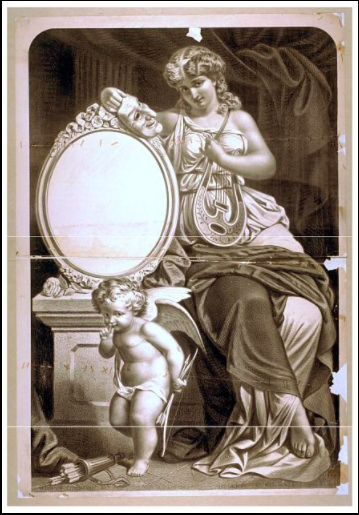Death
By Anonymous
Annotations by Abby Army

When Nature, chill with misty shades and clouds, Seems in her dark funereal vestments wrapped, And no glad brightness glimmers through her gloom, ‘Tis fit, I thought, O mightiest and most dread Of Phantoms! on thy sway to muse; to call Thee up from out thy caverns; and to look Upon thee, grim and ghastly as thou art; Crowned with sad cypress, in triumphal-wreaths[1], Betokening[2] thy victories o’er Hope, Youth, Beauty, all the smiling train of Joy.[3] As oft amid the flowers, and the bright Foliage of Spring we wander, drinking in The joyous sounds which burst from every chord Of Nature’s lyre, and blend their harmonies In one sweet strain of grateful offering To the pure SOURCE from whom their being came, Thy dark form rises in the distance dim, And with gigantic stride approaches us: By thy tempestuous breath each chord is broken Of that melodious lyre; the notes of joy Are changed to wild, unearthly sounds, that grate Upon the soul, and in its shattered celled Will echo long.[4] But Phantom still art thou: Though thou hast made us journey through a vale Where weeping-willows, dripping with their tears, Shut out the sun, and every breath of air Comes burdened with the weight of sighs, thy rule Must end. The tearful willows soon shall bloom With heaven’s brightest flowers; each tear-drop Beaming with purest rain-bow[sic] raidiance; The winds that sighed with vain regrets, And bore along the notes of woe, shall waft Upon their perfumed gales the voices clear Of the long-lost, but now for e’er regained.
As thy more ancient brother Chaos[5] fled, When, from the night of time, the morn arose: So shall the second and more glorious Rising of Beauty’s brilliant sun dispel Thee, shadowy wanderer in the vale of tears!
Anonymous. “Death.” The Knickerbocker; or New York Monthly Magazine, American Periodicals, 42, no. 6 (December 1853): 594.
Woman, Seated with Lyre, Thespian’s Mask, and Cupid. 1870. Photograph. Library of Congress. Created by Ferd. Mayer & Sons Mammoth Lithographic Print https://www.loc.gov/pictures/item/2014637344/
[1] Similar to a Laurel Wreath, this is a a round wreath made of connected branches and leaves of the bay laurel (Laurus nobilis), an aromatic broadleaf evergreen, or later from spineless butcher’s broom (Ruscus hypoglossum) or cherry laurel (Prunus laurocerasus). It is a symbol of triumph and is worn as a chaplet around the head, or as a garland around the neck. The symbol of the laurel wreath traces back to Greek mythology. Apollo (God of the Sun) is represented wearing a laurel wreath on his head, and wreaths were awarded to victors in athletic competitions (wikipedia.com)
[2] be a sign of; indicate. (Oxford Languages)
[3] Note the capitalization of “Hope, Youth, Beauty… and Joy” and how that changes these concepts from abstract to almost human, and familial.
[4] The end of this stanza juxtaposes the sounds of joy and pain. It is described in such a visceral manner that audiences can gather what the author truly means.
[5] The capitalization of Chaos reiterates the idea of abstract concepts as tangible people. This also reinforces the idea of these concepts as a family.
Resources for Further Study
- If you are interested in more works by the artist for “WOMAN, SEATED WITH LYRE, THESPIAN’S MASK, AND CUPID,” be sure to check out this website.
Pedagogy
Have students write related works focused on “Hope, Youth, Joy, Beauty, or Chaos.” See how each piece can be interrelated with “Death.”